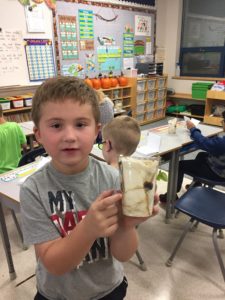Cognitive Tools shape how we make sense of our world and provide a framework in which meaningful connections can take place. I am learning the importance and value of integrating these tools into my pedagogy to facilitate enduring, in-depth learning.
The root system of a plant constantly provides the stems and leaves with water and dissolved minerals. In order to accomplish this, the roots must grow into new regions of the soil to allow for healthy plant development and eventually fruit. The opportunity to watch root growth is fascinating. This fall, my
students planted scarlet runner beans in paper towels. We patiently watched as these seeds took root. Much to our amazement, the roots began a magical journey around and around the plastic cups that contained their growth. Eventually they overtook their places of growth and we provided new soil and a bigger space to stretch.
 Our inquiry, like the invasive root system of our scarlet runners, spread into all areas of the curriculum. The nutrients in the life-giving soil were provided by the cognitive tools that propelled our learning forward into meaningful and memorable connections. We imagined the possibilities of magical beans; experienced a sensory-rich forest environment, were puzzled by our predictions of pumpkin seeds and wondered about life vs death in the cycle of living things. A Venn Diagram caused us to think about our oneness with trees and stretched us to understand the metaphorical imagery that the “Tree Song” described. Deeper went our roots; pedagogically supported by cognitive tools and the emotional significance they inspired.
Our inquiry, like the invasive root system of our scarlet runners, spread into all areas of the curriculum. The nutrients in the life-giving soil were provided by the cognitive tools that propelled our learning forward into meaningful and memorable connections. We imagined the possibilities of magical beans; experienced a sensory-rich forest environment, were puzzled by our predictions of pumpkin seeds and wondered about life vs death in the cycle of living things. A Venn Diagram caused us to think about our oneness with trees and stretched us to understand the metaphorical imagery that the “Tree Song” described. Deeper went our roots; pedagogically supported by cognitive tools and the emotional significance they inspired.
Resources:
“Learning in Depth” (Kieran Egan, 2012). Chapter 5 talks about how cognitive tools facilitate student interest and emotional connection in a topic.
“An Imaginative Approach to Teaching” (Kieran Egan, 2005). “The soul of teaching has to do with meaning. Everyone concerned with education, from the beginning, has recognized that the task is not simply to teach facts and skills that can be reproduced when required. The trick is to tie the facts and skills to their deeper meaning in human experience.” (pg. 211)
